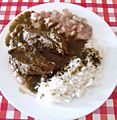Seco (food) facts for kids
| Alternative names | chicken stew, meat stew, goat stew, kid stew, chavelo stew, glove stew |
|---|---|
| Type | Stew |
| Main ingredients | Meat (chicken, beef or goat) and various seasonings. |
Seco is a yummy stew that is very popular in Ecuadorian cuisine and Peruvian cuisine. You can make it with different kinds of meat, like chicken, beef, or goat. It's known for its rich flavor and is often served with rice.
The word "seco" means "dry" in Spanish. This might seem strange because the dish is actually quite juicy! Some people think the name is a funny way to describe a stew that isn't dry at all.
Contents
What is Seco?
Seco is a type of stew where meat is cooked slowly in a flavorful sauce. The meat is often marinated first in something sour, like chicha (a traditional drink), beer, naranjilla (a fruit), or vinegar. This helps to make the meat tender and adds a special taste.
It's usually served with rice and sometimes other sides like potatoes, plantains, or beans.
Where Did Seco Come From?
People aren't exactly sure where Seco was first made. Some food experts, like Gloria Hinostroza, think it might have come from an Arab dish called seco tajine. This dish was made with lamb. Her brother, Rodolfo Hinostroza, agrees that it could have been brought to South America by slaves from North Africa a long time ago.
There are old records that show Seco was known in Peru and Ecuador as early as the 19th century. A German traveler named Ernst Wilhelm Middendorf visited Peru and wrote about "dry dishes" in the 1800s. He described them as chicken or goat meat cooked in a thin, spicy broth with yellow potatoes. He said these stews tasted much better than they looked!
A recipe for "seco de cabrito" (kid stew) was even in a Peruvian cookbook from 1926. In Ecuador, a book from 1930 mentioned that "dry chicken" was being made there since the early 1800s.
The Name's Story
There's a popular story about how Seco got its name. It's said that in the early 20th century, English oil workers in Ancón, Ecuador, would ask for the "second" course of their meal. Ecuadorians heard "second" and started saying "seco," and the name stuck!
However, this story is probably a myth. Records show that the dish existed as early as 1820, which is almost 100 years before the English workers were in that area. So, the real reason for the name "seco" is still a bit of a mystery!
Different Kinds of Seco
The type of Seco usually depends on the main meat used. Both Ecuador and Peru have their own special versions!
Seco in Ecuador
In Ecuador, how Seco is served can depend on whether you are in the mountains or on the coast.
- In the mountains, Seco often comes with white rice or rice cooked with achiote, ripe plantains, potatoes, and avocado.
- On the coast, like the manabita stew, it's often served with cooked or fried yuca and a salad.
Here are some popular Ecuadorian Seco dishes:
-
Goat stew with white rice and plantain
- Chicken Stew: This is a very common and festive dish. Chicken pieces are browned in a pot with tomato, onion, pepper, and spices like mint or cilantro. Then, they are cooked in a liquid made from blended ingredients, often with naranjilla juice or beer to give it a sour taste.
- Goat Stew: This stew is popular in certain provinces of Ecuador. The goat meat is marinated, often with chicha de jora or beer, to make it tender and reduce its strong flavor. Sometimes, lamb is used instead of goat.
- Guanta Stew: This is a special dish from the Ecuadorian Amazon. Guanta meat (a type of rodent) is mixed with garlic and beer. Then, it's cooked with fried onions, peppers, cilantro, and peanuts until it's soft. It's usually served with rice and fried plantains and yuca.
- Other Stews: You can also find Seco made with duck, lamb, beef, or even fish in Ecuador.
Seco in Peru
Peruvian Seco is a favorite dish, especially on the north coast and in the capital city, Lima. The main ingredient that gives it a special flavor is cilantro. It's often served with cooked beans and white rice.
- Kid stew (Seco de Cabrito): This is a very famous dish from the northern coast of Peru. It's made with young goat meat marinated in chicha de jora and cooked with cilantro, yellow pepper, and a special squash called loche. It's served with cooked yuca, a fresh criolla sauce, white rice, and beans. In some areas, it might even come with a tamale! A similar version uses lamb instead of kid.
- Chabelo stew (Seco Chabelo): This dish is from the Piura region in Peru. It's made with green plantains that are cooked and then mashed. This is mixed with roasted or dried beef (cecina) and seasoned with chili, tomato, and onion. Like other Seco dishes, it has a sour ingredient, usually chicha de jora.
- Other Stews: In Peru, you can also enjoy Seco made with chicken, beef (sometimes called lomo seco), duck, pork, fish, and even shrimp!
See also
 In Spanish: Seco (comida) para niños
In Spanish: Seco (comida) para niños








